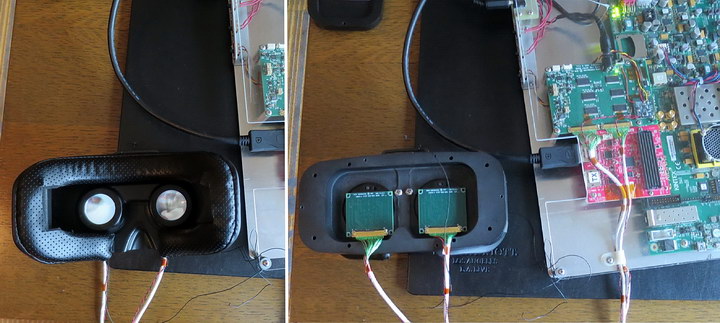While Kopin Corporation did not have an official presence at SID’s Display Week exhibition, I visited them in their suite at the nearby JW Marriott hotel where I was hosted by Greg Truman, Head of Industrial and European Businesses. Truman had originally been a ForthDD employee and went to Kopin with the Kopin acquisition of ForthDD.
Truman said Kopin is well-placed to serve the augmented reality (AR) and virtual reality (VR) communities because it can offer HMD designers in those communities their choice of microdisplay technologies: transmissive LCD, LCoS or OLED on silicon. The LCD technology represents Kopin’s original technology, the LCoS came from the company’s acquisition of ForthDD and the OLED technology is a more recent development and is being done in partnership with BOE and Olightek.
BOE is perhaps best known in the US and Europe as a supplier of panels for LCD TVs and as the company currently building, with partners, the worlds largest LCD fab, a Gen 10.5 fab in Hefei. This is in the company’s Display Devices Business Group and it has two other Business Groups: Smart System Business Group and Healthcare Service Business Group. BOE’s AR/VR activities are actually in its Smart System Group, not its Display Group. BOE is also heavily involved in the Internet of Things (IoT), also in the Smart System Group.
Olightek was founded in Yunnan in 2008 and focuses on AMOLED. According to the company, they were the first company in China to design and manufacture a full digital AMOLED microdisplay, which entered the market in 2009. In addition to finished microdisplays, the company provides OLED deposition services for other companies, such as Kopin and BOE. Current annual production of AMOLED microdisplays at Olightek is said to be more than 450,000 panels.
The Kopin/BOE/Olightek joint venture has been previously announced and involves the building of a green-field microdisplay fab for about $167M, with most of the money coming from BOE. Kopin’s patent portfolio is one of their key contributions to the JV. At Augmented World Expo (AWE) the week after SID was over, Kopin announced a few more details of the joint venture and said: “Kopin previously announced an alliance with BOE Technology Group Co. Ltd. (BOE) and Yunan OLiGHTEK Opto-Electronic Technology Co.,Ltd. for OLED display manufacturing. As part of that alliance, all parties will contribute up to an aggregate $150 million to establish a high-volume, state of the art facility to manufacture OLED micro-displays to support the growing AR and VR markets. The new facility, which would be the world’s largest OLED-on-silicon manufacturing center, will be managed by BOE and is expected to be built in Kunming, Yunnan Province, China over the next two years. BOE is the world leader in display panels for mobile phone and tablets.”
According to Truman, the capacity of the new fab will be “millions per year” and 50% of that capacity will go to Kopin. Production is expected to start in 2019. In the meantime, Kopin expects to get 10’s of thousands of OLED microdisplays out of the existing Olightek fab.
Truman also said that BOE has taken a 10% share of Kopin and will be building VR HMDs based on Kopin technology for the consumer market.
Exploded view of Kopin’s new OLED-based VR HMD (Image: Kopin)
At AWE, Kopin also announced their new VR HMD reference design, caked the Elf VR. The design uses two 2K x 2K OLED Lightning microdisplays. This VR HMD had previously been shown in January at CES (Kopin’s New 2Kx2K OLED on Si Panel to Advance VR Image Quality). Note that this is a “reference design,” not a product intended for sale to the mass market.
Technical specs given by Kopin include:
- Elf VR is equipped with Kopin “Lightning” OLED microdisplay panels, which feature 2048 x 2048 resolution of each panel, to provide binocular 4K image resolution at 120Hz refresh rate (Kopin claims that its dual 2K displays are the equivalent of a single 4K display. Previous work by Ray Soneira on the LG 3D passive displays suggests that there is some logic behind this claim, based on the way that the brain combines stereo 2D images to 3D). Combined with both 4K Ultra-High image resolution and 120Hz refresh-rate, Elf VR provides very smooth images with excellent quality, and effectively reduces the sense of vertigo, the company claims.
- The Microdisplay panels are manufactured with advanced ultra-precise processing techniques. Its pixel density was increased by approximately 400% compared to the conventional TFT-LCD, OLED and AMOLED display, and the screen size can be reduced to approximately 1/5 at similar pixel resolution level.
- Elf VR also adopts an advanced optical solution with a compact Multi-Lens design, which enabled it to reduce the thickness of its optical module by around 60%, and to reduce the total weight of VR HMD by around 50% as well, which can significantly improve the user experiences for longtime wearing.
- The reference design supports two novel optics solutions – 70 degrees FOV for ‘film-like beauty’ or 100 degrees FOV for deep immersion.
In the press release, Kopin discusses the Pixels Per Inch for the Kopin device compared to conventional LCD or OLED devices. This is not the correct measure of a display in a HMD – it should be measured in pixels/degree or, more commonly, Arc-minutes/pixel. With 2048 pixels in the Lightning display, the 70° FOV version of the Elf VR will have a resolution of 2.1 Arc-minutes/pixel and the 100° FOV version will have 2.9 Arc-minutes/pixel. This compares to a resolution of the human eye of about 1.0 Arc-minutes, so the pixels in the Elf VR system should still be visible to a viewer with normal vision. Still, the pixels in the Elf VR HMD should be much less visible than they are in other VR HMDs, especially ones where a single display shares its resolution between the two eyes.
 Prototype Elf VR HMD from Kopin at SID. Left: From the Viewer’s side. Right: Rear, with the cover removed and the Lightning microdisplays visible, plus part of the drive board. (Photo credit: M. Brennesholtz)
Prototype Elf VR HMD from Kopin at SID. Left: From the Viewer’s side. Right: Rear, with the cover removed and the Lightning microdisplays visible, plus part of the drive board. (Photo credit: M. Brennesholtz)
I got to try a prototype of the 70° FOV Elf VR unit in the Kopin Suite at SID. I can confirm that the pixel visibility was greatly reduced compared to other VR HMDs I have tried. While pixels were still slightly visible, this is probably an acceptable level for mass-market consumer acceptance. In addition, there was very little ‘screen door effect’, because of the high fill factor of the OLED on silicon microdisplay.
One thing to note about Kopin and Olightek AMOLED microdisplays is they are all color-by-white (CBW). That is, a white OLED material is used and red, green and blue colors are made by filtering the light. Due to the filters, which discard about 80% of the light produced by the OLED material, these devices are significantly less efficient than the OLED devices from eMagin that use patterned RGB OLED materials. These CBW microdisplays are well suited for VR HMDs where only modest brightness levels are required. For see-through AR devices where the image must contend with high ambient light and low-efficiency see-through optics, CBW OLEDs may not be suited. – Matthew Brennesholtz

